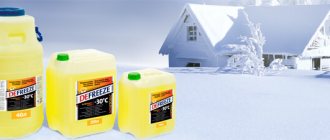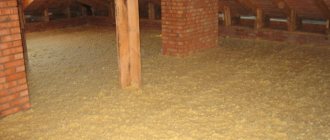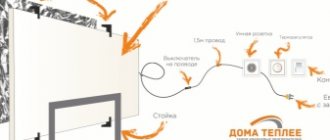Register Login
Publication date: October 23, 2020
Saving energy of all types - this task is increasingly facing humanity. There is no energy shortage on the planet yet, but the consequences of the process of converting it into electricity and heat make us think. Smog, ozone holes, excess of harmful metals in the atmosphere, contaminated precipitation, soil pollution and much more - all this primarily affects a person, his health, quality and life expectancy. Realizing this, people began to use alternative resources and energy-saving technologies, which are increasingly being used in everyday life and in the production process of various sectors of the economy.
Energy-saving technologies are recognized as a priority at the level of state internal policy in many countries and in Russia in particular. And this is not just a tribute to fashion, because every year the shortage of resources is felt more and more. Mining takes up a huge amount of resources - money, time, labor. And all together this has an extremely negative impact on the environment.
That is why it is rational to obtain energy from renewable sources and use the resulting resources sparingly. Energy-saving technologies are developed on the basis of innovative solutions; they are currently technically feasible and bring economic benefits. These technologies must also be environmentally friendly and not change the course of life of society as a whole and the usual way of doing things for each person individually. This is exactly how the UN defined the concept of energy saving.
Particularly large energy losses occur during energy consumption, with 10% lost when delivering it to the consumer. Therefore, if the goal of saving energy has arisen, then it is necessary to look for moments of its conservation precisely at the objects of consumption - in enterprises, workshops, offices, multi-storey and private buildings, etc. The means to achieve this goal is the use of energy-saving technologies. They work in two directions: improving energy production technologies and resource saving methods.
Alternative energy sources
Double glazing
Wind energy can be used not only by industrial or commercial enterprises. Many companies today produce special wind generators for individual farms. By installing such a generator on the roof of your house, you will save up to 50% of energy, despite its small size. If most of the energy is spent on heating and air conditioning, then double-glazed windows should be installed to help keep your home warm in winter and cool in summer.
Advantages and disadvantages
The positive aspects that explain the interest of developers in the construction of energy-efficient houses include:
- A properly built house creates a favorable indoor microclimate, ensuring comfortable living for people.
- Maximum reduction of heat losses and the use of alternative energy sources can significantly reduce utility costs.
- Such a house is an environmentally friendly building, which increases its market value and does not have a negative impact on the environment.
The disadvantages include:
- Difficulty in developing design documentation and meeting quality requirements for work at different stages of construction.
- High construction costs.
Heat supply ↑
A passive house is a warm house with minimal coolant consumption. Your home will be heated by a combined system, which includes a gas double-circuit boiler and a heat pump. The heat pump requires a well. A twin steel pipe is lowered to a depth of 100 meters. The upper half of the pipes is thermally insulated. The heat pump pumps a liquid mixture such as antifreeze through a pipe. At depth, the mixture heats up and releases heat inside the house. In severe frosts, the gas boiler turns on. Heat pumps pump coolant through the heating system. To heat the water, a solid fuel boiler is installed. It is heated with waste and wood debris. The energy-saving double-cycle boiler burns waste without residue without emitting smoke. You can make it yourself.
Thermal panels – energy-saving heating
Among energy-saving heating systems, thermal panels are becoming especially popular. Their advantages are economical energy consumption, functionality, and ease of use. The heating element consumes 50 Watts of electricity to warm up per 1 m², while traditional electric heating systems consume at least 100 Watts per 1 m².
A special heat-accumulating coating is applied to the back side of the energy-saving panel, due to which the surface heats up to 90 degrees and actively releases heat. Heating of the room occurs due to convection. The panels are absolutely reliable and safe. They can be installed in children's rooms, playrooms, schools, hospitals, private homes, and offices. They are adapted to voltage fluctuations in the electrical network and are not afraid of water and dust.
An additional “bonus” is the stylish appearance. The devices fit into any design. Installation is not difficult; all necessary fasteners are supplied with the panels. From the first minutes of turning on the device, you can feel the warmth. In addition to the air, the walls warm up. The only negative is that using panels is unprofitable in the off-season, when you only need to slightly heat the room.
PLEN is a worthy alternative
Film radiant electric heaters are one of the most interesting developments in the field of energy-saving heating technologies. PLEN systems are economical, efficient and quite capable of replacing traditional types of heating. The heaters are placed in a special heat-resistant film. PLEN is mounted on the ceiling.
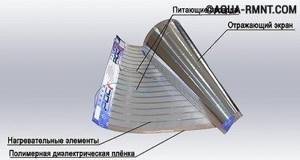
The film radiant electric heater is a complete structure consisting of power cables, heaters, a foil screen and high-strength film
The principle of operation of such a system
Infrared radiation heats the floor and objects in the rooms, and they, in turn, give off heat to the air. Thus, the floor and furniture also play the role of additional heaters. Due to this, the heating system consumes less electricity and produces maximum results.
Automation is responsible for maintaining the desired temperature - temperature sensors and a thermostat. The systems are electrical and fireproof, do not dry out the indoor air, and operate silently. Since heating occurs primarily by radiation and to a lesser extent by convection, PLENs do not contribute to the spread of dust. The systems are very hygienic.
Another important advantage is the absence of the release of toxic combustion products. The systems do not require special care, are harmless to human health, and do not poison the environment. With ceiling infrared heating, the warmest zone is at the level of the legs and torso of a person, which allows you to achieve the most comfortable temperature regime. The service life of the system can be 50 years.

An infrared heater does approximately 10% of the work of heating a room. 90% comes from the floor and large furniture. They accumulate and release heat, thus becoming part of the heating system
What makes PLEN so profitable?
The buyer incurs the greatest expenses at the time of purchasing a film heater. The design is easy to install, and if desired, you can install it yourself. This allows you to save on workers. The system does not require maintenance. Its design is simple, therefore durable and reliable. It pays for itself in about 2 years and can serve for decades.
Its biggest advantage is significant savings on electricity. The heater quickly warms up the room and then simply maintains the set temperature. If necessary, it can be easily removed and mounted in another room, which is very convenient and beneficial in case of moving.
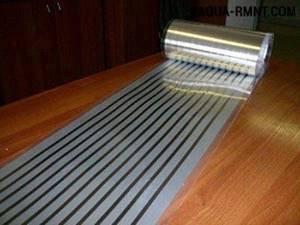
Infrared radiation has a positive effect on human health and activates the body's defenses. By installing PLEN, the owner of the house, in addition to heating, additionally receives a real physiotherapy room
Training film on editing PLEN
The video shows all the stages of installing a film heater:
Sewerage ↑
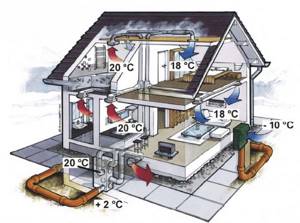
An energy-saving house passes household wastewater through a recuperator, removing heat to heat the air.
An energy-saving house passes all types of domestic waste through a recuperator, removing heat to heat the air. There is a septic tank 10-15 meters from the passive house. A two cubic meter plastic tank in which wastewater is processed by anaerobic bacteria. As it is processed, the treated wastewater is pumped onto a compost heap. Compost is not only a fertilizer for the garden, but also an excellent fuel for a hot water boiler.
What is an energy efficient home?
An energy-saving house is a building in which an optimal microclimate is maintained, while the consumption of various types of energy from third-party sources is at a low level of consumption in comparison with conventional buildings.
An energy-saving house has good thermal insulation, and not only receives thermal energy from external sources, but also serves as a heat source itself. Energy from third-party sources is used for heating, hot water supply and power supply for household appliances.
An energy-saving house is:
- A building that, thanks to its design, can significantly reduce the need for thermal energy.
- A house that is comfortable to live in thanks to the microclimate created in it.
Planning and design principles
They can be implemented by a developer who is engaged in the construction of housing with optimal energy consumption. Now there are a lot of technologies for this, recommended by special organizations. If necessary, you can familiarize yourself with such approaches yourself.
Architectural solution
It is important to think about the rational orientation of the walls of a private house in accordance with the cardinal directions. This solves the problem of insolation thanks to windows and balconies that are oriented to receive radiant energy for the maximum number of hours per day. For this purpose, the project is developed so that the building has an elongated shape with a maximum surface of transparent structures on the south side.
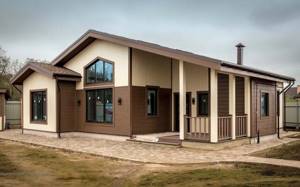
It is important to ensure that the shadow from neighboring structures should not obscure the window openings. It is also not advisable to plant tall trees that block the penetration of sunlight into the rooms.
Space planning measures
This includes measures that can reduce heat loss in the winter and save on air conditioning in the summer:
- arrangement of canopies over the windows on the south side, which do not prevent the penetration of rays during short daylight hours, but limit the overheating of the glass in the hottest time;
- thoughtful glazing area;
- additional vestibules at the entrance doors that maintain positive temperatures.
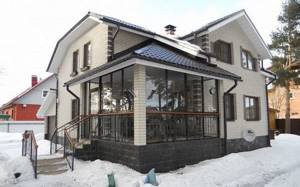
Structural mechanisms
It is necessary to provide for or eliminate all aspects that lead to irrational consumption of energy sources. They do this using the following solutions:
- ensuring the tightness of the building;
- the use of innovative double-glazed windows with filling of the inter-glass space with inert gases, with selective coating with special spraying, glass with built-in heating elements that convert the energy of sunlight, etc.;
- the insulating shell of the external perimeter of the house made of modern thermal insulators, which is made in one piece, without gaps.
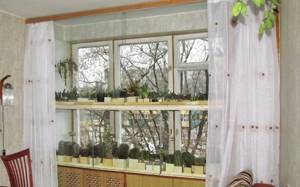
Previously, both external and internal wall insulation was used, then preference began to be given to external insulation, since with this approach temperature fluctuations become less pronounced due to the potential and thermal conductivity of brick, concrete and other materials. Recently, for greater efficiency, simultaneous insulation of both external and internal surfaces has been recommended, which allows increasing the indoor temperature by 6 - 10 ° C or significantly reducing heating costs.
Engineering approaches
For a private home, such energy-saving technologies are considered very effective, but the greatest result comes from their use in combination with other types:
- ventilation systems with heat recovery in winter or coolness in summer;
- use of sources located outside the building (solar energy, heat from reservoirs and land);
- re-consumption of heat generated inside the house (for example, heating water from the heat of a refrigerator or air conditioner);
- automatic control of technical devices and systems in the room (“Smart Home”).
Electric boilers
As with the heating system, the hot water supply system can use electrical energy obtained from solar power plants or wind generators. For this you can use electric energy-saving boilers.
The advantages of using electric boilers for heating and hot water supply systems are:
- Ease of installation and maintenance;
- Environmental safety and efficiency of devices;
- Long service life.
The disadvantages include dependence on uninterrupted power supply and additional load on the electrical network.

Energy-saving electric boilers are:
The difference between these types of boilers is in the process of converting electrical energy into heat. In addition to differences in design (type), boilers differ in: the number of working circuits, installation method, power, overall dimensions and other technical indicators determined by manufacturers.
Energy saving when using this equipment is achieved through:
- Reducing the heating inertia of devices;
- The use of special physical transformations of electrical energy into heat;
- Ensuring a smooth start when starting the work process;
- Use of automation systems to control the temperature of the coolant and air;
- Use of modern materials and technologies in manufacturing.

Price
The cost of energy-saving lamps, including LEDs, depends on their technical characteristics (power, color, etc.), the manufacturer of the devices, as well as the retail chain where the devices are purchased.
At the moment, the cost of energy-saving lamps produced by various companies and depending on the power in retail chains is:
- Production - from 120.00 to 350.00 rubles;
- Production - 250.00 to 500.00 rubles;
- Production - from 150.00 to 450.00 rubles;
- Production - from 200.00 to 350.00 rubles;
- Production - from 70.0 to 250.00 rubles.
LED light bulbs produced by various companies, depending on their technical characteristics, are sold in retail chains at the following prices:
- Production - from 300.00 to 3000.00 rubles;
- Production - from 300.00 to 2500.00 rubles;
- Production - 250.00 to 1500.00 rubles;
- Production - from 250.00 to 1200.00 rubles;
- Production - 200.00 to 1500.00 rubles;
- Production - from 200.00 to 2000.00 rubles.
The light source market offers products from other companies, both domestic and foreign, but the prices for these products lie within the specified ranges.





